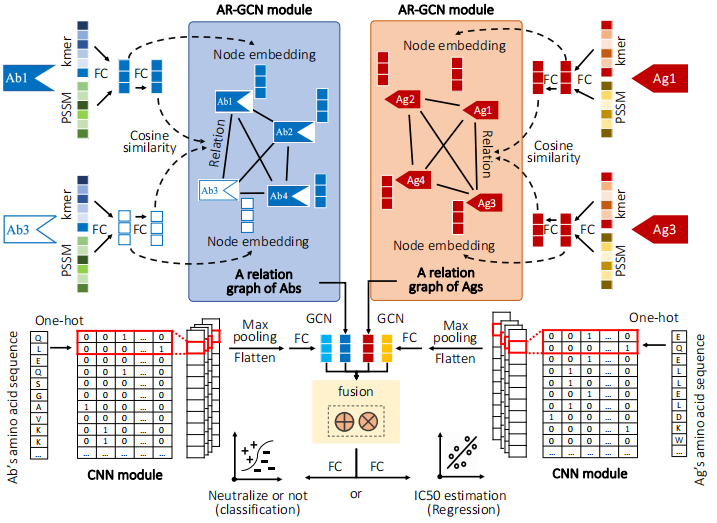Researchers Predict Unseen Antibodies Neutralizability via Adaptive Gnns
Date:14-11-2022 | 【Print】 【close】
Antibodies (Abs) opsonize and neutralize viruses, working as potent bio-pharmaceuticals in clinical treatments for their high specificity and affinity to antigens. However, most natural and synthetic antibodies are unseen --- their neutralization with any antigen need laborious and costly wet-lab experiments for demonstration. Predicting unseen Abs' neutralizability from amino acid sequences has two challenges: the well-known problem --an unseen Ab' neutralization with any Ag is unknown, and the effective features that can represent Abs’ neutralizability keeps undiscovered.
Recently, the team led by associate professor WU Hongyan from Shenzhen Institute of Advanced Technology of Chinese Academy of Science, together with SenseTime and Fudan University, developed a computational method for rapid screening of neutralizability of unseen antibodies.
The study was published in Nature Machine Intelligence with the title "Predicting unseen antibodies' neutralizability via adaptive Graph Neural Networks".
The proposed DeepAAI learns unseen antibody representation by constructing two adaptive relation graphs among antibodies/antigens and applying Laplacian smoothing between unseen and seen antibodies’ representation. Rather than using static protein descriptors, DeepAAI learn representations and relation graphs dynamically, optimized towards the downstream tasks --- neutralization prediction and IC50 estimation.
DeepAAI's performances are demonstrated on HIV, SARS-CoV2, influenza, and dengue. Moreover, the relation graphs have rich interpretability. The Ab graphs imply the similarity among Ab neutralization reactions, and the Ag graphs indicate the relation among a virus’s different variants. We accordingly recommended probable broad-spectrum Abs against a virus’s new variant.

Figure. DeepAAI consists of an ARGCN module and a CNN module, learning global representation among Abs/Ags and local representation inside an Ab/Ag, respectively. The AR-GCN adaptively constructs two relation graphs by quantifying relation among Abs and among Ags, and learn Ab and Ag representation from relation. (Image by SIAT)
"We explore probable broad spectrum Abs that may neutralize all the SARS-CoV2 variants. Among the total 2,587 SARS-CoV2 Abs," said Prof. WU, "deepAAI recommends the most 50 probable Abs. Among them, 5 Abs have been previously demonstrated and 34 Abs keep to be verified."

Table. Broad spectrum Abs recommended by DeepAAI. (Image by SIAT)